Chemical Peels
Chemical peels are used today to improve skin's texture, smooth out skin tone and lighten dark patches or hyper pigmentation, and to improve the appearance of fine lines and wrinkles.

Chemical peels are used today to improve skin's texture, smooth out skin tone and lighten dark patches or hyper pigmentation, and to improve the appearance of fine lines and wrinkles.
A Chemical peel or skin peel involves
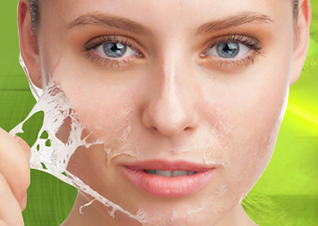 The application of a specific solution to the surface of the skin to peel away the outermost layers, revealing the fresh skin beneath. This skin peeling method is used to treat a variety of skin conditions including acne, rosacea, fine wrinkling, blotchy pigmentation, ingrown hairs, yellow complexion and dry skin. Chemical peels are most often performed on the face but may also be beneficial on the neck, chest, back, hands, arms and legs.
The application of a specific solution to the surface of the skin to peel away the outermost layers, revealing the fresh skin beneath. This skin peeling method is used to treat a variety of skin conditions including acne, rosacea, fine wrinkling, blotchy pigmentation, ingrown hairs, yellow complexion and dry skin. Chemical peels are most often performed on the face but may also be beneficial on the neck, chest, back, hands, arms and legs.
Why Use A Chemical Peel?
Chemical peels, also known as chemical resurfacing, are chemical treatments to produce an improved appearance of the face. Chemical peels are used for the treatment of photoaging (from sun damage), wrinkles, scarring, acne, pre-cancerous lesions, and discoloration (dyschromia) or uneven skin tone. Chemical peels produce controlled injury to the skin to promote the growth of new skin with an improved appearance.
How to Get Great Peel Results
- A Chemical peel or skin peel involves the application of a specific solution to the surface of the skin to peel away the outermost layers, revealing the fresh skin beneath.
- Chemical peels are chemical treatments to produce an improved appearance of the face.
- There are two layers of the skin. The outer layer is called the epidermis and the inner layer, the dermis.
- The depth of chemical peeling depends on the type of chemical used.
Glycolic Peels
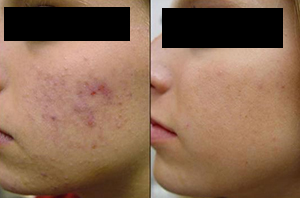 Glycolic acid does not produce a lot of visible peeling, making it awesome for those always on the go.
Glycolic acid does not produce a lot of visible peeling, making it awesome for those always on the go.
Glycolic 30% is the choice for a younger person (18-25) as an age prevention peel or can be used by someone with a more sensitive skin who may not be able to tolerate a stronger peel.
Glycolic Acid 50% is a mid-range peel that’s a perfect starter for mature skin or a step up peel for younger skin. Glycolic 50% is best for normal skin types seeking to address the first signs of aging, maintaining deeper peel results, or is perfect for those who can't afford downtime.
The Glycolic 70% the strongest AHA peel we offer. It is ideal for someone with mature, sun damaged skin that has had some previous peel experience. This peel is not recommended for your first time experience with Glycolic peeling on the face, but may be used for first time body treatments. Glycolic 70% will produce an overall rejuvenation after 3-6 peel treatments, however this peel can be applied every 3 weeks indefinitely.
Glycolic Peel Information
Who Should Use It: Glycolic Acid works best on dry to normal skin types and is generally safe for most skin tones. It works particularly well on sun damaged, dull skin that is showing fine lines and loss of firmness. Sensitive skin should start with Glycolic 30% and progress in potency over time.
How Get The Best Results: Make sure you are using all the tools in your peel kit. The Pre Peel cleanser is designed specifically for washing the skin before a peel, even though it can also be used daily. The Pre Peel Solution ensures the maximum penetration of the Glycolic acid and the Neutralizer stops the peel once your processing time is up. Be sure to plan your next peel within 2-3 weeks of your first peel and keep repeating at that frequency until you have achieved your goal. Glycolic is a progressive peel and needs to have at least 8-10 consecutive applications to get the full benefits.
What To Expect: A temporary burning sensation or reddening of the skin is possible, but this is not indicative of whether the peel is or is not working. The skin will gradually feel tighter and drier over the next 24 to 72 hours. Very light to moderate flaking will start around the mouth and nose region and gradually work outward. This may continue for several days. Vigilant broad-spectrum sunscreen use is crucial for post-peel success.
Maintenance: For best results, glycolic peels should be performed at regular intervals. Daily skin care should include the appropriate serum and moisturizer along with regular exfoliation. Use of SPF 30 (daily wear) or higher (SPF 45-55 for long term sun exposure) is a must.
Jessner's Peel
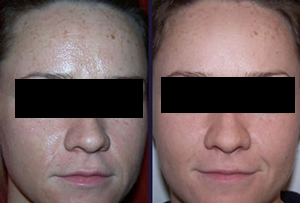 The Jessner Peel combines the benefits of three popular peeling agents: resorcinol, salicylic acid, and lactic acid. Effectively lightens hyperpigmentation, treats and prevents acne, and renews sun damaged skin.
The Jessner Peel combines the benefits of three popular peeling agents: resorcinol, salicylic acid, and lactic acid. Effectively lightens hyperpigmentation, treats and prevents acne, and renews sun damaged skin.
The Jessner Peel is generally considered a medium level peel containing 14% of each acid (Salicylic, Lactic, and Resorcinol.) The depth of this peel is determined by the number of layers applied during application and the tolerance level of the skin it is applied to. It is recommended that new users begin with 1-3 layers for a light/medium peel. Generally 4-6 layers will result in a medium/deep peel and 7-8 layers can result in a deep peel.
Skin Type: Jessner Peel is suitable for most skin types particularly normal to oily, acneic, and sun damaged. Sensitive and dry skin types should consult with one of our estheticians to determine if the Jessner peel is an appropriate choice for them.
Benefits: Improved skin tone, texture and clarity. Reduction of acne, clogged pores, shallow wrinkles, and fine lines. Increase in collagen and elastin production.
Maintenance: Maintain your new vibrant skin with MedPeel Salicylic 2% Daily Exfoliator and Age Defy SPF 30 Moisturizer.
TCA Peels
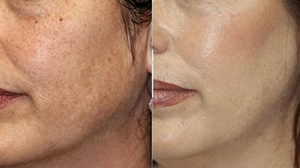 Trichloroacetic Acid, often referred to as TCA, is an effective chemical agent used to exfoliate and renew the skin on a superficial to medium level. TCA is most frequently applied to the face, neck, décolleté, and hands. In addition, TCA is also an excellent "spot treatment" and can be used to exclusively peel isolated areas of the skin.
Trichloroacetic Acid, often referred to as TCA, is an effective chemical agent used to exfoliate and renew the skin on a superficial to medium level. TCA is most frequently applied to the face, neck, décolleté, and hands. In addition, TCA is also an excellent "spot treatment" and can be used to exclusively peel isolated areas of the skin.
A Multi-Tasking Peel For Potent Results
The range of depth achieved from a TCA Peel varies according to concentration potency, application methods and of course skin type. Upon application, the solution goes deep into the skin’s dermis actively seeking protein to neutralize itself. The time and pressure employed will also have a substantial effect on the TCA Peel’s permitted depth of skin penetration. For minor epidermal improvement, TCA 10% Light Peel will be effective. However, if skin concerns exist within the papillary dermis, a stronger solution will be required.
The Skin-a-Peel
Fine lines and wrinkles, hyperpigmentation, stretch marks, acne as well as an uneven skin tone can all serve to benefit from a TCA Peel.
TCA Peel Information
Skin Type: Trichloroacetic is generally safe for most skin types particularly normal to oily, sun damaged, dull, and uneven skin. Sensitive skin should progress product potency over time.
Standard Benefits: Improved skin tone, texture and clarity. Reduction of acne, clogged pores, wrinkles and fine lines. Increase in collagen and elastin production. (Trichloroacetic Acid is also beneficial for gradually removing unwanted freckles, tattoos and scars.)
Side Effects: A temporary burning sensation has been noted upon initial contact as well as heightened skin sensitivity, flaking, light frosting, redness and swelling. Vigilant broad-spectrum sunscreen use is crucial for post-peel success.
Potency/Strength: Ranging from LIGHT (10%), MEDIUM (20%) and DEEP (30%).
Downtime: Moderate – Varies accordingly to individual skin traits and selected TCA concentration/application methods.
Salicylic Peels for Acne-Prone Skin
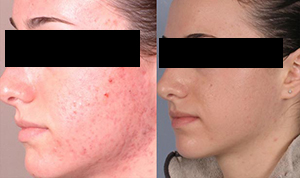 Salicylic Acid chemical peels work to reduce bacteria, inflammation and excessive sebum from deep within the pore that can otherwise proliferate and create a rough, blotchy appearance. The multifaceted Salicylic chemical peel gently addresses many of the systemic root causes of acne blemishes. Aside from Salicylic Acid’s appetite for acne, its function as an anti-fungal agent can also provide substantial relief to those suffering from chronic yeast overgrowth (Candida). Salicylic Acid peels also provide marked improvements in skin tone, texture and clarity.
Salicylic Acid chemical peels work to reduce bacteria, inflammation and excessive sebum from deep within the pore that can otherwise proliferate and create a rough, blotchy appearance. The multifaceted Salicylic chemical peel gently addresses many of the systemic root causes of acne blemishes. Aside from Salicylic Acid’s appetite for acne, its function as an anti-fungal agent can also provide substantial relief to those suffering from chronic yeast overgrowth (Candida). Salicylic Acid peels also provide marked improvements in skin tone, texture and clarity.
Salicylic Peel - Results
With use of this peeling solution, your skin may become red and take on a frosting appearance during application. In some cases, the skin will have a temporary anesthesia or numbing effect. Breakouts may also occur after peeling. This reaction is normal and the breakout is due to the pores cleansing and bringing debris to the surface. Your skin should begin to balance out within a few weeks, leading to clearer and less oily skin.
Available Strengths: 2% – 30% (Results will vary upon selected strength)
Salicylic Acid Peel
Particularly effective is the salicylic acid peel, as it is able to penetrate deeper into the skin - removing blackheads, whiteheads and diminishing fine lines. At a concentration of 10 to 30 %, salicylic acid peels have a much higher level of concentration than drugstore salicylic acne creams, which are typically at 1 to 5%.
Typically, the peel is placed on the skin for a period not exceeding 20 minutes. There is slight tingling involved, but the process should not cause any pain or discomfort. Once removed, the skin may appear red and shiny, but this will fade within a couple of hours if the peel performed is superficial. A mild lotion or cream may be applied to help with soothing, and makeup can usually be applied immediately or within a day.
Salicylic Peel Information
Skin Type: Salicylic Acid is generally safe for most skin types particularly normal to oily, sun damaged, sensitive, dull, uneven and dehydrated. Sensitive skin should progress product potency over time.
Standard Benefits: Reduction of acne inflammation, clogged pores, seborrheic dermatitis, psoriasis, ingrown hairs, wrinkles and fine lines, improved texture and clarity.
Side Effects: A temporary numbing effect has been noted upon initial contact as well as heightened skin sensitivity, purging, redness and peeling. Vigilant broad-spectrum sunscreen use is crucial for post-peel success.
Downtime: Mild/Moderate – Varies accordingly to individual skin traits and selected Salicylic Peel strength/potency. Superficial to medium depth peels approximately require a 7 to 10 day recuperation period. Salicylic Acid’s purging effect may necessitate a longer healing period.
Maintenance: Maintain long-term results of a Salicylic Peel with regular use of MedPeel’s Salicylic Acid 2% Exfoliator as well as habitual use of SPF 30 or higher.
Chemical peels for men: Benefits and Types
Chemical peels for men
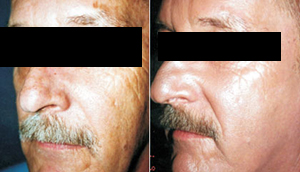 There was a time when cosmetic procedures, from facelifts to liposuction to chemical peels, were considered almost exclusively the domain of women. In those bygone years, a man would probably have been embarrassed to even consider going in for appearance enhancing treatments, much less actually making an appointment at a spa or clinic. But those days are gone! In the modern era, men are heading to the cosmetologist in ever greater numbers, and with head held high. Men, we now know, have as much right to looking younger and more healthy as women do.
There was a time when cosmetic procedures, from facelifts to liposuction to chemical peels, were considered almost exclusively the domain of women. In those bygone years, a man would probably have been embarrassed to even consider going in for appearance enhancing treatments, much less actually making an appointment at a spa or clinic. But those days are gone! In the modern era, men are heading to the cosmetologist in ever greater numbers, and with head held high. Men, we now know, have as much right to looking younger and more healthy as women do.
Benefits of chemical peels for men
As a man puts on a few years, his skin can begin to look a little tired. Whether on his face, his chest, his neck, or even his hands, the effects of time and the environment will begin to show through in lines and wrinkles, dark patches or uneven pigmentation, enlarged pores, or a more pronounced appearance of acne scars from youth as the skin loses its suppleness. Chemical peels stop and even reverse this effect of time by rejuvenating the skin.
During the peel procedure, a caustic agent is applied to the face or body. This agent effectively removes the outer layers of dead skin cells, revealing the newer, more supple layers just below. In doing so, the chemical peel lifts out fine lines and wrinkles, scars, sun and age spots, and enlarged pores, all without the trouble and risk of face lifts or other surgeries. The whole procedure can take under an hour and can be easily scheduled into your busy day. What’s more, because the chemical peel is an intensive procedure, it will require only periodic maintenance treatments or can be a once in a lifetime treatment, depending on the type you receive.
Types of chemical peels for men
Chemical peels fall roughly into three categories, depending on the strength of the agent used in the procedure. Men may receive chemical peels that are relatively mild in action, intermediate in their intensiveness, or peels that work to rejuvenate the skin at the deepest of levels. Which variety of peel you will require depends on the condition of your skin and your desired level of appearance enhancement.
At the mildest end of the spectrum, your clinic or spa will apply an agent such as one of the alpha hydroxy acids that will gently exfoliate dead skin cells. These often all-natural agents work over the course of several days to lift off the dead layers of skin that can cause you to look older than you are.
The next level of chemical peels involves the use of an agent such as trichloroacetic acid. This chemical is stronger than the alpha hydroxyls and thus works at a deeper level to smooth out scars and wrinkles. A peel at the intermediate level lasts several months without maintenance treatments, thus reducing trips to the cosmetologist.
Finally, the chemical peel at the deepest level of penetration uses strong caustics agents such as phenol to produce the most dramatic of appearance enhancements. The phenol reaches deep into the skin layer to lift out and smooth scars, uneven pigmentation, and enlarged pores. Because this treatment is so intensive, it can be a once in a lifetime procedure.
Whichever type of peel you desire, the key issue is you—how you look, how you feel, the side of yourself you show to the world. Looking your best is your right and your prerogative, whether you are a woman or a man.
The benefits of a peel vs microdermabrasion
As we get a bit older, our skin begins to take on the all too familiar signs of aging: the appearance of small wrinkles around the eyes and corners of the mouth, enlarged pores that interrupt the smooth surface of the skin, and a gradual dulling of the skin’s natural luster. But although these changes are part of the aging process, there is much we can do to delay, halt, or even reverse the appearance of aging. Two of the most popular techniques available to do so are chemical peels and microdermabrasion.
While the two procedures involve different techniques and use different active agents, the treatments have similar goals. Both microdermabrasion and peels are undertaken by people looking to reduce fine lines and wrinkles, the appearance of enlarged pores and acne scars, and discolorations to the skin caused by sun exposure or age. The procedures are both mostly done on the face but are also useful for skin rejuvenation of the hands, back, chest, or neck. The two procedures are similar in that they work to remove the outer layer of the skin, the dermis, thus uncovering the firmer, more supple and younger skin that lies beneath.
Many people consider microdermabrasion the less invasive of the two treatments. In this procedure, the skin is showered with microscopic crystals made from aluminum oxide. The effect of this is something like having you’re the skin of your face or other body part gently sanded to remove the dermis, the outer layers of dead skin cells. The procedure is less intensive than chemical peels, resulting in a less rigorous removal, and thus rejuvenation, of the skin.
In the chemical peel, an acidic agent is applied to the skin, ranging from the relatively mild glycolic acid peel, to the more intermediate trichloracetic acid peel, to the strongest of peels that utilize phenol. These treatments work by having the caustic agents loosen, remove, and dissolve the older skin that results in wrinkling, enlarged pores, dark spots, and scarring. The effects of chemical peels, because the agents used are stronger than those used in microdermabrasion, are that much more dramatic, leaving the skin looking fresh and supple.
In addition to the deeper treatment offered by peels, another advantage of chemical peels is its much longer lasting effects. For good results, microdermabrasion requires approximately 6 to 12 initial sessions with the cosmetologist, with maintenance sessions performed every 2 or 3 months after that. Peels, on the other hand, might require maintenance sessions every few months for the milder varieties of the technique, or may only require a single, life-time session for the most rigorous of the agents used. Certainly this is not only a significant time saver compared with microdermabrasion but a cost saver over time as well.
Of course, as with all cosmetic procedures, safety is important. Chemical peels use intensive chemicals in the process of rejuvenating your skin, so you will want to make sure you are visiting spas or clinics well trained in these types of treatments. Chemical peels, although not entirely without their risks of side effects, are very safe when performed by those well familiar with the technique and the aftercare of your skin. Discomfort and chances of side effects can be greatly reduced with proper follow up and care.
In the end, it is up to you which procedure you will chose, and you should consult with your cosmetologist on the treatment that will best serve your needs. Most important is that you are happy with the results, that you, and your skin, look great and feel great. The possibility for you to look healthier and years younger is right there at your fingertips.
